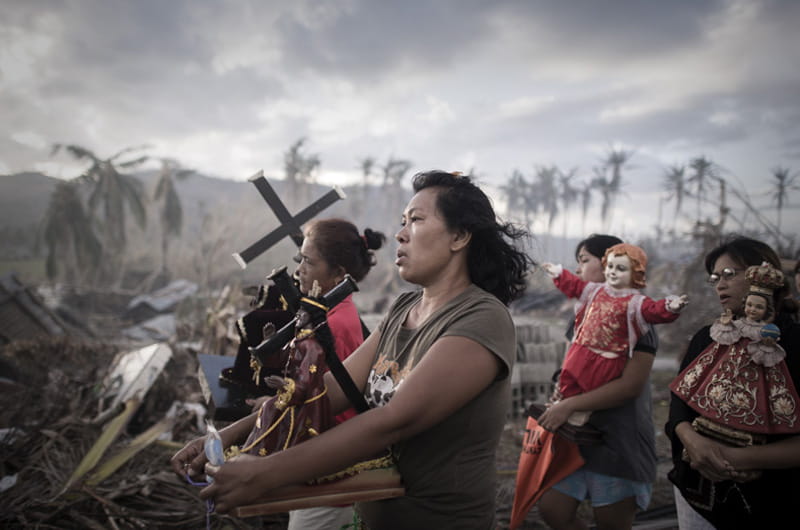Last Chance to See 2014 World Press Photo Exhibition at Drexel

- ‘The Philadelphia Challenge’ is Ready for You
- When Climate Disasters Hit, They Often Leave Long-term Health Care Access Shortages, Drexel Study Finds
- New Research Highlights Health Benefits of Using Heritage Art Practices in Art Therapy
- Chief Defender at the Defender Association of Philadelphia, Keisha Hudson, Will Address Drexel Kline School of Law Graduates at Commencement

“Powerful images of conflict, hope and daily life” (Associated Press) are currently on display as part of an exhibition of nearly 150 prize-winning photos from the 57th Annual World Press Photo competition, the world’s largest and most prestigious annual international press photography contest, which made its United States debut at Drexel University.
The photos will be on display through Wednesday, May 21, in the URBN Center Annex’s Leonard Pearlstein Gallery (3401 Filbert St.) of Drexel’s Antoinette Westphal College of Media Arts & Design. The gallery is free and open to the public, Tuesdays through Sundays from 11 a.m. – 6 p.m.
The photos will be on display through Wednesday, May 21, in the URBN Center Annex’s Leonard Pearlstein Gallery (3401 Filbert St.) of Drexel’s Antoinette Westphal College of Media Arts & Design. The gallery is free and open to the public, Tuesdays through Sundays from 11 a.m. – 6 p.m.
“We are thrilled to bring this extraordinary exhibition of the world’s outstanding photojournalism to Drexel,” said Curry. “It’s fitting that Philadelphia, so crucial to the history of journalism in this country, will be host to this stunning show.”
The World Press Photo of the Year 2014, selected from close to 100,000 entries, is an image by American photographer John Stanmeyer on assignment for National Geographic magazine. The picture shows African migrants on the shore of Djibouti city at night, raising their phones in an attempt to capture an inexpensive signal from neighboring Somalia—a tenuous link to relatives abroad. Djibouti is a common stop-off point for migrants in transit from such countries as Somalia, Ethiopia and Eritrea, seeking a better life in Europe and the Middle East. The picture also won first prize in the Contemporary Issues category.
The World Press Photo of the Year 2014, selected from close to 100,000 entries, is an image by American photographer John Stanmeyer on assignment for National Geographic magazine. The picture shows African migrants on the shore of Djibouti city at night, raising their phones in an attempt to capture an inexpensive signal from neighboring Somalia—a tenuous link to relatives abroad. Djibouti is a common stop-off point for migrants in transit from such countries as Somalia, Ethiopia and Eritrea, seeking a better life in Europe and the Middle East. The picture also won first prize in the Contemporary Issues category.
The international jury of leading photojournalism professionals gave prizes in nine themed categories to 53 photographers of 25 nationalities from: Argentina, Australia, Azerbaijan, Bangladesh, Bulgaria, China, Czech Republic, El Salvador, Finland, France, Germany, Iran, Italy, Jordan, Mexico, The Netherlands, New Zealand, Poland, Russia, Serbia, South Africa, Spain, Sweden, the UK and the USA.
The members of the jury announced the winners at a press conference held at the World Press Photo offices in Amsterdam on Feb. 14. For an overview of all the winners, visit: http://www.worldpressphoto.org/awards/2014
Click on the photos below for photo credit and description:
The judging was conducted at the World Press Photo office in Amsterdam. All entries were presented anonymously to the jury, who discussed their merits over a two-week period. The jury operates independently and a secretary without voting rights safeguards the fairness of the procedure. The contest drew entries from professional press photographers, photojournalists and documentary photographers across the world. By the mid-January deadline, 98,671 images had been submitted by 5,754 photographers from 132 countries.
The judging was conducted at the World Press Photo office in Amsterdam. All entries were presented anonymously to the jury, who discussed their merits over a two-week period. The jury operates independently and a secretary without voting rights safeguards the fairness of the procedure. The contest drew entries from professional press photographers, photojournalists and documentary photographers across the world. By the mid-January deadline, 98,671 images had been submitted by 5,754 photographers from 132 countries.
World Press Photo receives support from the Dutch Postcode Lottery and is sponsored worldwide by Cannon.
About World Press Photo
World Press Photo organizes the leading international contest in visual journalism. The foundation is committed to supporting and advancing high standards in photojournalism and documentary storytelling worldwide. Its aim is to generate wide public interest in and appreciation for the work of photographers and other visual journalists, and for the free exchange of information. The activities include organizing annual photojournalism and multimedia contests and global exhibition tours. The Academy programs strive to stimulate high-quality visual journalism through educational programs, grants and by creating greater visibility through a variety of publications. World Press Photo is an independent, non-profit organization with its office in Amsterdam, the Netherlands, where it was founded in 1955.
Drexel News is produced by
University Marketing and Communications.